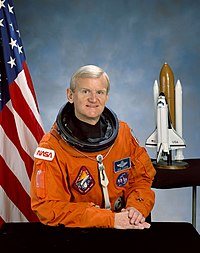John Casper
| John Casper | |
|---|---|

|
|
| Country: | United States |
| Organization: | NASA |
| selected on | May 23, 1984 ( 10th NASA Group ) |
| Calls: | 4 space flights |
| Start of the first space flight: |
February 28, 1990 |
| Landing of the last space flight: |
May 29, 1996 |
| Time in space: | 34d 9h 52m |
| retired on | 1997 |
| Space flights | |
John Howard Casper (born July 9, 1943 in Greenville , South Carolina ) is a retired American astronaut .
Casper received a bachelor's degree in engineering from the US Air Force Academy in 1966 and a master's degree in aerospace engineering from Purdue University in 1967 . He is a 1986 graduate of Air War College . Casper joined the Air Force in 1968 and, after completing his training as a pilot, was sent to the Vietnam War , where he flew a total of 229 combat missions. From 1970 to 1974 he was stationed in Great Britain . After his return to the USA, Casper was trained as a test pilot and was used as such until 1980. He then served in the United States Department of Defense as assistant director of special projects office.
Astronaut activity
In May 1984, Casper was selected by NASA as an astronaut candidate. After completing his training as a shuttle pilot, he was employed in the astronaut's office as head of the Operations Development Branch. He led the development of the controls, brakes and tires of the nose wheel and the development of a landing parachute. He was astronaut team leader for the Shuttle Avionics Integration Laboratory (SAIL) and liaison speaker ( CAPCOM ) in the control center.
After his last space flight in 1996, Casper was appointed director of safety and quality at the Johnson Space Center .
After the Columbia disaster in 2003, he was a member of the investigation team and also worked on the return-to-flight program to resume shuttle flights.
STS-36
Casper took off into space for the first time on February 28, 1990 as a pilot of the space shuttle Atlantis . A secret US Air Force satellite was dropped into low orbit from where this digital reconnaissance satellite was supposed to monitor most of the earth's surface.
STS-54
With the space shuttle Endeavor Casper started as commander on January 13, 1993 for the mission STS-54 . The main objectives of this mission were to deploy the US $ 200 million Tracking and Data Relay Satellite (TDRS-F) and experiment with X-ray astronomy with the Diffuse X-ray Spectrometer (DXS).
STS-62
On March 4, 1994, Casper flew into space as the commander of the Columbia space shuttle . The main payloads of the two-week mission were USMP-2 (United States Microgravity Payload) and OAST-2 (Office of Aeronautics and Space Technology). Numerous experiments from different disciplines were carried out during the flight.
STS-77
The STS-77 mission started with the space shuttle Endeavor on May 19, 1996 and was the fifth mission of the commercial Spacehab module. A dozen experiments from the fields of biology , electrical engineering and agriculture were carried out there. Furthermore, the SPARTAN platform was suspended, which in turn carried the so-called Inflatable Antenna Experiment (IAE). The $ 14 million IAE was an aluminum-coated plastic shell that was shaped into its actual shape - an antenna dish - using nitrogen gas. The ten-day operation was the first flight to be managed from takeoff to landing from the new Consolidated Control Center (CCC) in Houston.
Private
John Casper and his wife Beth have four children.
See also
Web links
- Short biography of John Casper at spacefacts.de
- NASA biography of John Casper (English; PDF)
- Biography of John Casper in the Encyclopedia Astronautica (English)
| personal data | |
|---|---|
| SURNAME | Casper, John |
| ALTERNATIVE NAMES | Casper, John Howard |
| BRIEF DESCRIPTION | American astronaut |
| DATE OF BIRTH | July 9, 1943 |
| PLACE OF BIRTH | Greenville , South Carolina |